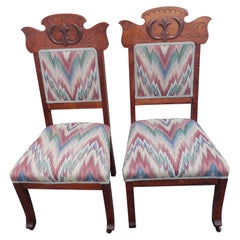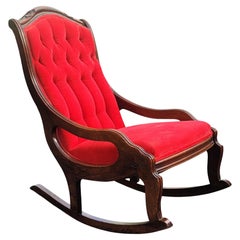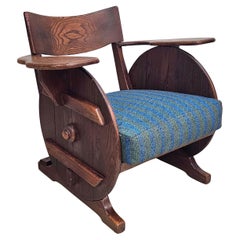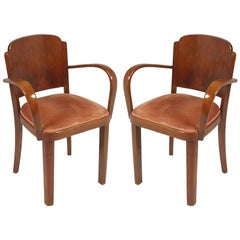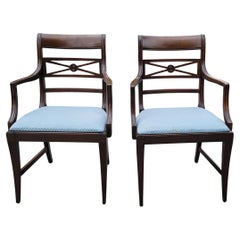1920s Upholstered Chair
Early 20th Century American Eastlake Side Chairs
Upholstery, Mahogany
Early 20th Century American Late Victorian Side Chairs
Upholstery, Oak
Early 20th Century American Late Victorian Rocking Chairs
Upholstery, Velvet, Mahogany
Early 20th Century Side Chairs
Upholstery, Velvet, Walnut
Mid-20th Century Italian Art Deco Dining Room Chairs
Upholstery, Walnut
Early 20th Century American Arts and Crafts Lounge Chairs
Upholstery, Oak
Early 20th Century Italian Art Deco Side Chairs
Velvet, Walnut
Early 20th Century French French Provincial Bergere Chairs
Silk, Walnut
Early 20th Century American Regency Armchairs
Upholstery, Mahogany
Early 20th Century Armchairs
Walnut
20th Century American Club Chairs
Early 20th Century French Chairs
Upholstery, Wood
Vintage 1920s English Club Chairs
Early 20th Century French Art Deco Club Chairs
Brass
Vintage 1920s English Club Chairs
Vintage 1920s French Side Chairs
Vintage 1920s British Arts and Crafts Dining Room Chairs
Fabric, Upholstery, Hardwood
Vintage 1920s French French Provincial Bergere Chairs
Upholstery, Hardwood
Early 20th Century French Art Deco Wingback Chairs
Metal
Early 20th Century Swedish Victorian Dining Room Chairs
Early 20th Century French Chairs
Cotton, Wood
Early 20th Century British Baroque Wingback Chairs
Oak, Linen
Early 20th Century American Armchairs
Hardwood, Upholstery
Early 20th Century Italian Dining Room Chairs
Brass
Early 20th Century American Armchairs
Upholstery
Vintage 1920s European Early Victorian Armchairs
Fabric, Mahogany
Antique Early 1900s English Neoclassical Club Chairs
Wood
Early 20th Century Art Deco Bergere Chairs
Giltwood, Maple, Velvet
Vintage 1920s French Side Chairs
Linen, Walnut
Vintage 1920s French Wingback Chairs
Cane
Vintage 1920s Dutch Art Deco Lounge Chairs
Upholstery, Oak
Early 20th Century American Louis XVI Dining Room Chairs
Leather
Early 20th Century Swedish Neoclassical Bergere Chairs
Wood, Upholstery
Early 20th Century Unknown Wingback Chairs
Upholstery, Wood
Early 20th Century French Dining Room Chairs
Upholstery, Wood
Vintage 1920s French Art Deco Lounge Chairs
Mahogany
Vintage 1920s Danish Chesterfield Armchairs
Brass
Early 20th Century Swedish Art Deco Armchairs
Birch
Vintage 1920s American Spanish Colonial Dining Room Chairs
Early 20th Century Club Chairs
Early 20th Century Club Chairs
Giltwood
Early 20th Century American Renaissance Revival Chairs
Velvet, Wood
Vintage 1920s Dining Room Chairs
Velvet, Wood
Early 20th Century French Louis XIII Dining Room Chairs
Fabric, Walnut
Early 20th Century American Club Chairs
Early 20th Century French Slipper Chairs
Fabric, Wood
Early 20th Century English Armchairs
Oak
Early 20th Century French Armchairs
Early 20th Century Armchairs
Early 20th Century Armchairs
Wood
Vintage 1920s Armchairs
Leather
Vintage 1920s French Art Deco Living Room Sets
Mohair, Wood
21st Century and Contemporary Armchairs
Vintage 1920s Spanish Colonial Dining Room Chairs
1920s Upholstered Chair For Sale on 1stDibs
How Much is a 1920s Upholstered Chair?
Finding the Right Seating for You
With entire areas of our homes reserved for “sitting rooms,” the value of quality antique and vintage seating cannot be overstated.
Fortunately, the design of side chairs, armchairs and other lounge furniture — since what were, quite literally, the early perches of our ancestors — has evolved considerably.
Among the earliest standard seating furniture were stools. Egyptian stools, for example, designed for one person with no seat back, were x-shaped and typically folded to be tucked away. These rudimentary chairs informed the design of Greek and Roman stools, all of which were a long way from Sori Yanagi's Butterfly stool or Alvar Aalto's Stool 60. In the 18th century and earlier, seats with backs and armrests were largely reserved for high nobility.
The seating of today is more inclusive but the style and placement of chairs can still make a statement. Antique desk chairs and armchairs designed in the style of Louis XV, which eventually included painted furniture and were often made of rare woods, feature prominently curved legs as well as Chinese themes and varied ornaments. Much like the thrones of fairy tales and the regency, elegant lounges crafted in the Louis XV style convey wealth and prestige. In the kitchen, the dining chair placed at the head of the table is typically reserved for the head of the household or a revered guest.
Of course, with luxurious vintage or antique furnishings, every chair can seem like the best seat in the house. Whether your preference is stretching out on a plush sofa, such as the Serpentine, designed by Vladimir Kagan, or cozying up in a vintage wingback chair, there is likely to be a comfy classic or contemporary gem for you on 1stDibs.
With respect to the latest obsessions in design, cane seating has been cropping up everywhere, from sleek armchairs to lounge chairs, while bouclé fabric, a staple of modern furniture design, can be seen in mid-century modern, Scandinavian modern and Hollywood Regency furniture styles.
Admirers of the sophisticated craftsmanship and dark woods frequently associated with mid-century modern seating can find timeless furnishings in our expansive collection of lounge chairs, dining chairs and other items — whether they’re vintage editions or alluring official reproductions of iconic designs from the likes of Hans Wegner or from Charles and Ray Eames. Shop our inventory of Egg chairs, designed in 1958 by Arne Jacobsen, the Florence Knoll lounge chair and more.
No matter your style, the collection of unique chairs, sofas and other seating on 1stDibs is surely worthy of a standing ovation.
- What is an upholstered chair?1 Answer1stDibs ExpertSeptember 28, 2021An upholstered chair is a type of chair where the sitting area and backrest are cushioned with foam covered in fabric or leather. This cushioning makes it very comfortable to sit on. On 1stDibs, find a variety of antique and vintage upholstered chairs and other upholstered seating.
- What do I wear to a 1920s party?1 Answer1stDibs ExpertMarch 3, 2023To a 1920s party, you can wear a short fringed or beaded flapper dress, layers of long beaded or pearl necklaces, elbow-length gloves and a feathered headband. Another option is to wear an off-white men's suit. Shop a selection of vintage apparel on 1stDibs.
- 1stDibs ExpertMarch 22, 2022In the 1920s, flappers often wore straight, fitted dresses with plunging necklines and knee-length hems. Fringe was a common embellishment used at the time. Flappers also sported pumps and opted for bras and lingerie instead of corsets for undergarments. Shop a variety of vintage clothing on 1stDibs.
- What is 1920s furniture called?1 Answer1stDibs ExpertNovember 13, 2024What 1920s furniture is called depends on its style. However, the most prominent design style of the decade was Art Deco. The term alone conjures visions of the Roaring Twenties, Machine Age metropolises, vast ocean liners, sleek typography and Prohibition-era hedonism. The iconic movement made an indelible mark on all fields of design throughout the 1920s and ’30s, celebrating society’s growing industrialization with refined elegance and stunning craftsmanship. Art Deco furniture often featured bold geometric lines, floral forms, shimmering mirrored finishes, sleek metal accents, and the use of expensive materials such as shagreen or marble as well as exotic woods such as mahogany, ebony and zebra wood. On 1stDibs, find a diverse assortment of Art Deco furniture.
- 1stDibs ExpertApril 5, 2024The clothing style in the 1920s that most people think of first is the flapper style. Women who dressed in this style sported loose-fitting, short dresses, often outfitted with drop waists and fringe. Small cloche hats and headbands were signature accessories of the flapper look. During the decade, pleated tennis skirts and cardigan sweater sets left the courts and became staples of some women's everyday styles. For men, soft collars replaced stiff, starched ones, and simple single and double-button suit jackets worn without waistcoats became trendy. Trousers also took on a new shape with wider-cut legs, and Oxford bags gained popularity. On 1stDibs, shop a variety of 1920s apparel and accessories.
- What are 1920s dresses called?1 Answer1stDibs ExpertFebruary 13, 2023The iconic dresses from the 1920s are called flapper dresses. This name comes from the term flapper, which was used to describe young women during the period who enjoyed personal fulfillment and independence in American cities, particularly as they gained the right to vote and enjoy other freedoms previously reserved for men. Flappers danced at jazz clubs and upended most societal restrictions placed on women at the time, and fashion statements typically attributed to flappers included short “bob” haircuts, higher hemlines and other then-audacious style choices. Find a selection of flapper dresses on 1stDibs.
- What era is 1920s jewelry?1 Answer1stDibs ExpertDecember 4, 2023What era 1920s jewelry is depends on its design. Most people associate this decade with the Art Deco movement, which took inspiration from eclectic sources like Cubism, ancient Egypt and Native American, African and Asian motifs. However, some pieces produced during the 1920s are more in line with the style trends of earlier periods, such as Art Nouveau, Edwardian and Victorian. Explore a diverse assortment of 1920s jewelry on 1stDibs.
- 1stDibs ExpertJune 15, 2023In the 1920s, fashionable colors included jewel tones. Fashion, jewelry, furniture and decorative objects often featured jade green, deep reds, amethyst purple, dusty mustard yellow and peacock blue. Find a range of 1920s-era jewelry and fashion on 1stDibs.
- 1stDibs ExpertMay 5, 2023In the 1920s, brides often wore tubular-shaped slip dresses with a beaded tunic over top. Hemlines usually fell just below the knee or to the ankle, and many gowns had dropped waists. For headwear, brides often showed off veils attached to cloche or flapper-style headbands. On 1stDibs, shop a collection of wedding dresses from some of the world’s top boutiques.
- 1stDibs ExpertApril 5, 2022To upholster a channel back chair, you will need to remove the seat and back of the chair, measure for new padding and upholstery and make specialized cuts and patterns for the channels. Upholstering channel back chairs is challenging, so if you’re not experienced in upholstering furniture, it’s best to take it to someone who is. Shop a selection of upholstered channel chairs from top sellers on 1stDibs.
- 1stDibs ExpertMay 5, 2023The type of tile that was used in the 1920s was primarily ceramic. Many shapes were available, including basketweave, penny round, pinwheel, square and subway. Hexagon tiles, however, which are still on trend, have been in use in bathrooms since at least the early 1900s. The choice of hexagonal tiles is believed to have been tied to cleanliness, as the small pieces could stand up to aggressive cleaning and could be easily replaced if needed. On 1stDibs, shop a collection of tiles from some of the world's top sellers.
- 1stDibs ExpertApril 5, 2022Flapper dresses from the 1920s came in a range of colors, although darker hues such as black and navy were immensely popular. Flapper dresses were cut with straight and slim silhouettes, were typically knee-length and had a lower neckline. They were often made from silk chiffon and featured beaded details. You’ll find a selection of 1920s flapper dresses from some of the world’s top sellers on 1stDibs.
- 1stDibs ExpertNovember 21, 2023In the 1920s, engagement rings still looked like rings but were representative of a diverse range of styles and influences. Art Deco diamond ring designs took inspiration from the contemporary Cubist movement as well as from ancient Egypt – a revival sparked by the opening of King Tut’s tomb in 1922. Native American, African and Asian motifs also inspired jewelry pieces. Diamonds in square and rectangular shapes incorporating angular steps – like emerald cuts, Asscher cuts and baguettes – were set against black onyx, rubies, sapphires and emeralds to create color-blocking effects. Platinum, 18-karat gold, 14-karat white gold and sterling silver were some of the favored metals of the decade. Find a wide range of Art Deco engagement rings on 1stDibs.
- 1stDibs ExpertJanuary 10, 2025Coco Chanel was considered one of the leading fashion designers in the 1920s and ’30s in Paris. The first Chanel shop was established in 1910 on rue Cambon by the young milliner Gabrielle Chanel, who had picked up the nickname “Coco” while working as a club singer. The boutique drew the attention of the Parisian fashion elite, who popularized her wide-brimmed Chanel Modes hats. Soon, she added a sportswear store in the Normandy resort town of Deauville, where Coco set the tone for her defining sense of style — traditionally masculine garments reimagined for feminine shapes, made from simple jersey fabric. Effortless and elegant, Chanel's designs promoted comfort and grace in women’s wear that had been dominated in the previous century by complicated layers of fabric and cumbersome corsets. She followed this success with a couture house, opened in 1915 in Biarritz. In 1926, Chanel introduced her first little black dress, reclaiming a color that had once been reserved for mourning and working-class women. That same decade, she debuted her perfume, Chanel No. 5, as well as the Chanel suit with a fitted skirt, inspired by the boxy lines of men’s clothing and employing a sporty tweed. During the 1920s, she also unveiled the predecessor for the 2.55 Flap bag, which remains one of Chanel's most popular offerings. Shop a large selection of Chanel apparel, bags and accessories on 1stDibs.
Read More
20 Inviting Dining Rooms Perfectly Arranged for Entertaining
Top interior designers show — and tell — us how to create delectable spaces for hosting dinner parties.
Nobody Puts This Sunny Sofa in a Corner
With its plush cushions, cane details and dazzlingly colorful back, it’s inviting from every angle.
The 21 Most Popular Mid-Century Modern Chairs
You know the designs, now get the stories about how they came to be.
Fred Rigby’s Modular Seating Can Be Configured in So Many Handy Ways
The plush Cove Slipper 2.5 Seater sofa is just one of many convenient combinations from the London-based maker.
This Chubby-Chic Quilted Stool Stands on Its Own Two Feet
Sam Klemick's cool stool is edgy, cozy and environmentally sustainable all at once.
Is Lionel Jadot the Willy Wonka of Upcycled Belgian Design?
From his massive collaborative workshop in a former paper factory, the designer concocts funky furniture from disused materials, as well as luxe hotel interiors like the new Mix Brussels.
Rock Your Cares Away on This Sunny Hand-Crocheted Swing
The boho-chic Enchanted Forest Swing, handmade by marginalized women from Turkey and Syria, is uplifting in every way.
Learn Why Designer Maarten Baas Set This Charles Rennie Mackintosh Chair on Fire
What happens when you do something to a piece of furniture that you shouldn’t? It becomes an entirely new object.
